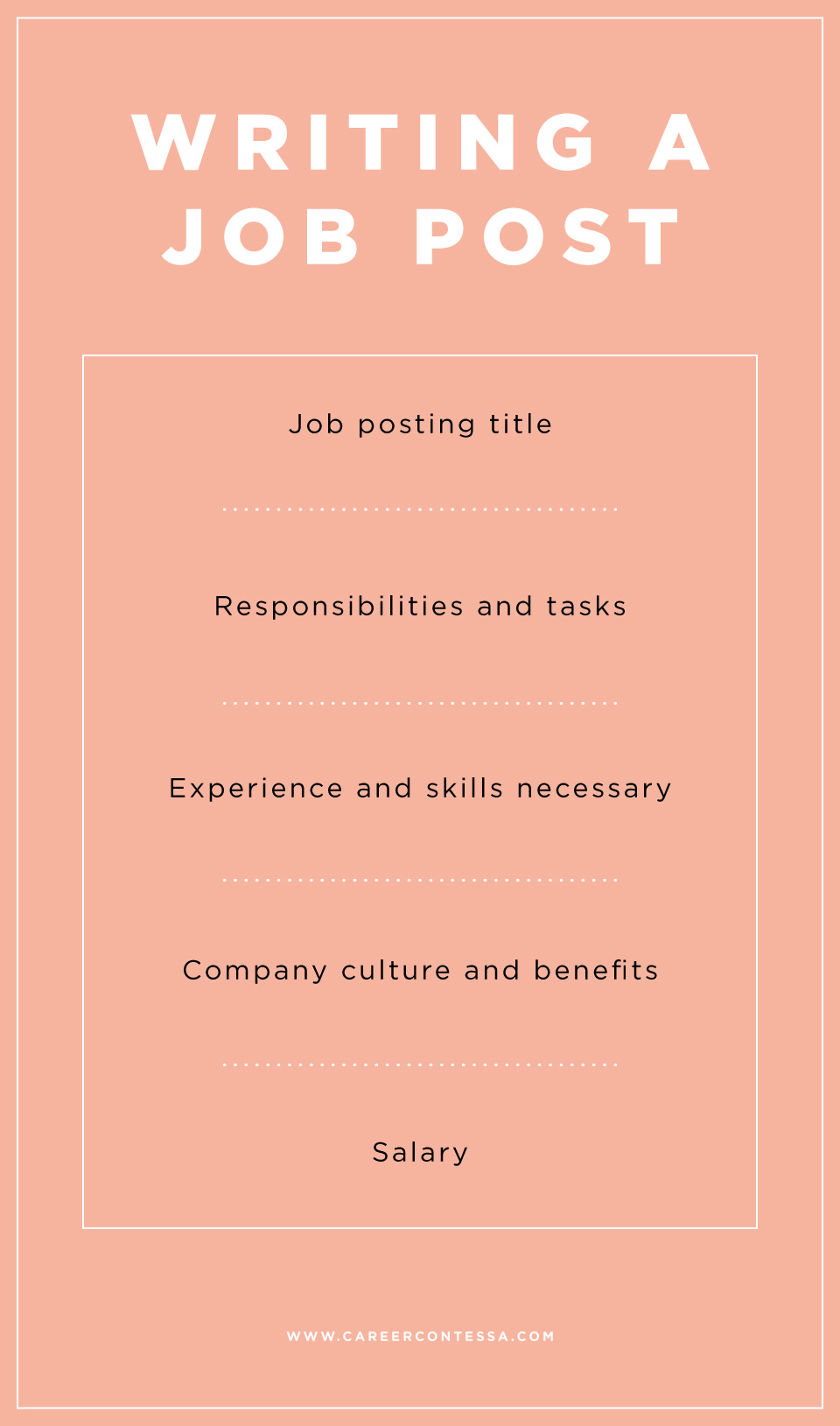Everybody does something for the first time once, right?
For a newly-minted manager or a first-time CEO, making your first hire is a huge milestone.
When you’re making your first hire, there’s a lot to think about. What applicants are you trying to attract? What is
your management style going to look like? What are your dealbreakers? What are your must-haves and your nice-to-haves? What red flags are you looking for?
We put together this guide to help you to define what you want in
your new employee, how to look out for warning signs, and how to conduct the best interview for your hiring needs.
Writing A Job Post
Ahh, the job post. This is likely the first piece of content your prospective employee is going to see in relation to your business—make it count. The job post or
job description can be annoying to write, but it’s essential to get it right. To make it easier, you can break down your job description to five key elements.
- Job posting title: Before any potential candidate is going to apply to a job, they are going to have to click on the actual job post. Yes, that’s right, it’s 2019 and your job post must be click-worthy. Looking for an administrative assistant? Instead of writing “Administrative Assistant Needed,” have something that will stand out more. Try something like “Seeking Awesome Administrative Assistant for High-Growth Startup.”
- Responsibilities and tasks: I know, I know. This is the most boring part. Just do it. Lay out the daily, weekly, and monthly responsibilities and tasks you need from this hire. Are there any really exciting elements to this position? Showcase them. Use this area to outline the responsibilities, but also the opportunities. If this hire will have opportunities to grow and learn, communicate that in this section. Remember, it’s a job seeker’s market right now—sell the position to them.
- Experience and skills necessary: This one is pretty self-explanatory. This is where you will lay out what experience is necessary for a candidate. Whether it’s education, in-office experience, hard skills, or soft skills, use this section to lay it all out. At best, every applicant will meet these requirements. At worst, you will receive applicants who ignore them altogether—put those applicants in the “no” pile straight away. In the middle ground? You might find applicants who don’t quite meet your requirements but who are motivated to learn and grow with you. Sometimes, green and ready applicants are the best ones. Pay attention!
- Company culture and benefits: Use this section to illustrate your company culture, whatever it may be. No, you don’t need to have a dedicated foosball room or an in-office gym in order to have a company culture. Company culture is, instead, a reflection of your company’s mission and values. Do you offer education benefits? Do you have daily all-hands meetings? Do you offer remote Fridays? All of these small details feed into your over-arching company culture. Lay it out here. Don’t forget to include any benefits you offer—whether it’s medical, dental, a 401k, or unlimited vacation policies.
- Salary: This is a hotly contested issue in the job post game. Do you lay it all out there in the job post? Maybe. If your salary offer is flexible or based on experience, you might not want to include it in your job posting. However, if your budget is extremely tight, you might consider doing everyone a favor by listing it in the job post from the beginning.
Selecting Interviewees
You wrote the job post, posted it to a ton of job boards, shared it on social media, and spread it through word of mouth. Now, you have an inbox full of ready applicants. How do you sort through them?
Well, let’s rewind a bit. Before you even write a word of your job post, you should have decided what your ideal applicant looks like. In the spirit of list-making (
we love lists here at Career Contessa) we want you to make two lists.
One is the YES-NO-MAYBE list and one is the ALL-MOST list.
YES-NO-MAYBE List
This is the first filter you will want to put your resumes through. Simply put, this filtration will eliminate the applicants that are not a fit for the position—whether it’s because she lacks certain skills, she didn’t follow instructions, or she hasn’t the right experience.
- YES: The applicant who you would hire based on resume and cover letter alone
- NO: The applicant you would not hire based on resume and cover letter (or lack thereof, facepalm) alone
- MAYBE: The applicant you might consider based on the cover letter, resume, and a little more information
The ALL-MOST List
The ALL-MOST list is the second filtration—this is where you separate the candidates who appear to ‘have it all’ from the ones who have most of what you need—and who seem promising despite maybe not looking ‘the best’ on paper. Remember, the phone and an in-person interview will tell you so much more than a few pieces of paper could.
- ALL: The applicant who ‘has it all’
- MOST: The applicant who has most of it, but is willing to learn
From here, you can make more lists and filter out applicants. This might not be the most helpful advice but always go with your gut. If a candidate doesn’t have all the skills and requirements but she wrote a stunning cover letter, she is likely worth an interview. Conversely, if she is excellent on paper, but gives your pause during the in-person interview, take note.
Compiling Interview Questions
You made some lists and you checked them twice. From here, you will want to
conduct some interviews. While you could start by inviting a dozen or so applicants to your office, that is an enormous time suck—for you and for each applicant. To avoid wasting a ton of time, schedule a phone interview first.
The Phone Interview
Most employers choose to conduct a
phone interview before an in-person. During a phone interview, you may ask some culture fit questions, some questions about her resume, and some questions about skill sets and previous experience. If you didn’t list your salary offer on your job post, this will be the time to discuss that. Don’t go too far into an actual interview process without both being on board with the salary, even if it’s a range.
The phone interview will tell you a lot. It will likely weed out a few more applicants, leaving you with a few serious candidates. Here are a few questions you can ask your prospective employee over the phone:
- Tell me a little bit about your work history.
- Why are you looking to leave your current company?
- What is the biggest challenge you have seen at your current position and how did you overcome it?
- Describe a substantial win in your last position.
- What was your favorite/least favorite element of your last position?
- How can you contribute to our company’s success?
- How well do you work by yourself, with a team?
- Why are you interested in coming to work for us?
- Why are you attracted to this specific position?
- What makes you the ideal candidate for this position?
- When can you come in for an in-person interview?
- (If you're applying to a job in another city) Are you willing to relocate? If we don't provide relocation assistance, are you still willing
- What are your salary requirements?
- How far along are you in your search? Are you speaking to other companies?
- Tell me about [x] in your resume
- Where do you see yourself in five years?
- What questions do you have for me?
The In-Person Interview
It’s time to invite the candidate(s) into your office. We’re getting really close to a hire—how exciting! There are many ways you can structure the in-person. Here is a step-by-step in making sure the in-person interview goes as smoothly as possible.
- Offer the interview over email with several time slots to choose from
- Send the candidate directions and parking instructions
- Prepare interview questions beforehand (Do not “wing it”)
- Invite other team members to interview candidates, if applicable
Use the in-person interview to ask on-the-spot
interview questions to further qualify your candidate. Consider inviting several members of your team to sit with the candidate to ask their own line of questions.
Send a Follow-up Letter or Email to Everyone
Chances are you are only going to hire one person for this position. That being said, follow up with each candidate you interviewed. I repeat, f
ollow up with each candidate, even if they didn’t get the job.
Job searching is a difficult time. Even if you are the most qualified candidate in the world, it can be a time that fills you with incredibly powerful
self-doubt and imposter syndrome. As an employer, you should always follow up with each candidate. Express gratitude for the time they took out of their schedules, explain that you have decided to hire elsewhere, and maybe sprinkle in a compliment or two. Do not ghost your applicants. It’s bad business.
Making the Right Decision
Making a new hire costs
an average of $4,000, so do it right. If you have taken care to be attentive throughout the entire process, you will be aware of warning signs, promising signs, and everything in between.
If you conducted a multi-person interview, where several members of your team interviewed the candidate separately, speak with them. Whether in a group or one-on-one, speak to your current team about what they experienced. This will make visible some blind spots you might have had.
Speak to your team about who they think would be the best fit for the long term. Keep in mind that some of your current team might interface with the new employee more than yourself. Make sure they feel heard when making your decision. Hiring a team member that does not gel with your current team can result in complete chaos—don’t let that happen.
Make the Offer
Once you and your team have picked the ideal candidate, make an offer. Depending on your style, you may offer the job via email or by phone. Offering via email puts less pressure on the applicant to feel as if she needs to answer right away. In addition, offering via email gives you a place to lay out the details of the offer so that she can take the time to review and (hopefully!) accept.
Happy (first-time) hiring!












